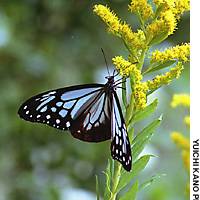* Japanese name: Asagi madara
* Scientific name: Parantica sita
* Description: Chestnut tigers are large butterflies, with a 43-65 mm wingspan and a striking blue-green marbled pattern on the wings. The body is black with white spots. Butterflies from this family (Danaidae) are also distinctive because their front legs are vestigial -- they are useless for walking. Males have a black mark on their hind wings. They fly lazily, in a laid-back manner, without really moving their wings much. Despite their large size, chestnut tigers are rarely attacked by birds, probably because their bright colors indicate they have tough bodies that taste bad.
* Where to find them: All over Japan, but especially in Kanto, from April to November. Chestnut tigers appear once or twice a year, depending on the weather and food conditions. They can be seen from the cities (even central Tokyo) to the mountains and woods. They are most easily spotted around mikan (Japanese mandarin) trees, okatorano (joe-pye weed) and hiyodoribana (loosestrife).
* Food: Nectar from flowers, especially from those in the milkweed family.
* Special features: Migration. Despite their apparent laziness, chestnut tigers can fly at great altitudes and can travel huge distances. How can such a small animal travel so far? By drifting along on seasonal winds. The butterflies store fat in their abdomen to see them through the long journey. From April to June, they migrate northwards; from September to November, they return south to lay eggs. Many chestnut tigers travel 1,000 km. In an exceptional case, one marked in Hakuba in Nagano Prefecture was later found 1,784 km away on Miyako Island.
4 hours ago


















With your current subscription plan you can comment on stories. However, before writing your first comment, please create a display name in the Profile section of your subscriber account page.